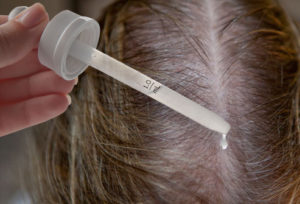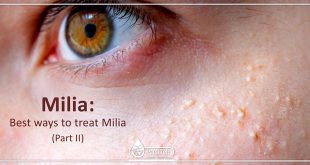Hair loss causes and different types of treatment
Most people normally shed 50 to 100 hairs a day. This usually doesn’t cause noticeable thinning of scalp hair because new hair is growing in at the same time. Hair loss occurs when this cycle of hair growth and shedding is disrupted or when the hair follicle is destroyed and replaced with scar tissue.
The exact cause of hair loss may not be fully understood, but it’s usually related to one or more of the following factors:
- Family history (heredity)
- Hormonal changes
- Medical conditions
- Medications
Family history (heredity)
The most common cause of hair loss is a hereditary condition called male-pattern baldness or female-pattern baldness. It usually occurs gradually and in predictable patterns — a receding hairline and bald spots in men and thinning hair in women.
Heredity also affects the age at which you begin to lose hair, the rate of hair loss and the extent of baldness. Pattern baldness is most common in men and can begin as early as puberty. This type of hair loss may involve both hair thinning and miniaturization (hair becomes soft, fine and short).

Hormonal changes and medical conditions
A variety of conditions can cause hair loss, including:
- Hormonal changes. Hormonal changes and imbalances can cause temporary hair loss. This could be due to pregnancy, childbirth or the onset of menopause. Hormone levels are also affected by the thyroid gland, so thyroid problems may cause hair loss.
- Patchy hair loss. This type of nonscarring hair loss is called alopecia areata (al-o-PEE-she-uh ar-e-A-tuh). It occurs when the body’s immune system attacks hair follicles — causing sudden hair loss that leaves smooth, roundish bald patches on the skin.
- Scalp infections. Infections, such as ringworm, can invade the hair and skin of your scalp, leading to scaly patches and hair loss. Once infections are treated, hair generally grows back.
- Other skin disorders. Diseases that cause scarring alopecia may result in permanent loss at the scarred areas. These conditions include lichen planus, some types of lupus and sarcoidosis.
- Hair-pulling disorder. This condition, also called trichotillomania (trik-o-til-o-MAY-nee-uh), causes people to have an irresistible urge to pull out their hair, whether it’s from the scalp, the eyebrows or other areas of the body.
Medications
Hair loss can be caused by drugs used for cancer, arthritis, depression, heart problems, high blood pressure and birth control. Intake of too much vitamin A may cause hair loss as well.
Other causes of hair loss
Hair loss can also result from:
- Radiation therapy to the head. The hair may not grow back the same as it was before.
- A trigger event. Many people experience a general thinning of hair several months after a physical or emotional shock. This type of hair loss is temporary. Examples of trigger events include sudden or excessive weight loss, a high fever, surgery, or a death in the family.
- Certain hairstyles and treatments. Excessive hairstyling or hairstyles that pull your hair tight, such as pigtails or cornrows, can cause traction alopecia. Hot oil hair treatments and permanents can cause inflammation of hair follicles that leads to hair loss. If scarring occurs, hair loss could be permanent.
Symptoms
Hair loss can appear in many different ways, depending on what’s causing it. It can come on suddenly or gradually and affect just your scalp or your whole body. Some types of hair loss are temporary, and others are permanent.
Signs and symptoms of hair loss may include:
- Gradual thinning on top of head. This is the most common type of hair loss, affecting both men and women as they age. In men, hair often begins to recede from the forehead in a line that resembles the letter M. Women typically retain the hairline on the forehead but have a broadening of the part in their hair.
- Circular or patchy bald spots. Some people experience smooth, coin-sized bald spots. This type of hair loss usually affects just the scalp, but it sometimes also occurs in beards or eyebrows. In some cases, your skin may become itchy or painful before the hair falls out.
- Sudden loosening of hair. A physical or emotional shock can cause hair to loosen. Handfuls of hair may come out when combing or washing your hair or even after gentle tugging. This type of hair loss usually causes overall hair thinning and not bald patches.
- Full-body hair loss. Some conditions and medical treatments, such as chemotherapy for cancer, can result in the loss of hair all over your body. The hair usually grows back.
- Patches of scaling that spread over the scalp. This is a sign of ringworm. It may be accompanied by broken hair, redness, swelling and, at times, oozing.

When to see a doctor
See your doctor if your child or you are distressed by hair loss and want to pursue treatment. Also talk to your doctor if you notice sudden or patchy hair loss or more than usual hair loss when combing or washing your or your child’s hair. Sudden hair loss can signal an underlying medical condition that requires treatment.
Risk factors
A number of factors can increase your risk of hair loss, including:
- Family history
- Age
- Poor nutrition
- Certain medical conditions, such as diabetes and lupus
- Stress
Treatments and drugs
Effective treatments for some types of hair loss are available. But some hair loss is permanent. With some conditions, such as patchy alopecia, hair may regrow without treatment within a year.
Treatments for hair loss include medications, surgery, laser therapy, and wigs or hairpieces. Your doctor may suggest a combination of these approaches in order to get the best results.
The goals of treatment are to promote hair growth, slow hair loss or hide hair loss.
Medication
If your hair loss is caused by an underlying disease, treatment for that disease will be necessary. This may include drugs to reduce inflammation and suppress your immune system, such as prednisone. If a certain medication is causing the hair loss, your doctor may advise you to stop using it for at least three months.
Medications are available to treat pattern baldness. Two medications approved by the Food and Drug Administration (FDA) to treat hair loss are:
- Minoxidil (Rogaine). Minoxidil is an over-the-counter liquid or foam that you rub into your scalp twice a day to grow hair and to prevent further hair loss. It may be used by men and women. With this treatment, some people experience hair regrowth, a slower rate of hair loss or both. The effect peaks at 16 weeks and you need to keep applying the medication to retain benefits.
Possible side effects include scalp irritation, unwanted hair growth on the adjacent skin of the face and hands, and rapid heart rate (tachycardia).
- Finasteride (Propecia). This prescription drug is available only to men. It’s taken daily in pill form. Many men taking finasteride experience a slowing of hair loss, and some may show some new hair growth. You need to keep taking it to retain benefits.

Surgery
In the most common type of permanent hair loss, only the top of the head is affected. Hair transplant or restoration surgery can make the most of the hair you have left.
During this procedure, your surgeon removes tiny plugs of skin, each containing a few hairs, from the back or sides of your scalp. He or she then implants the plugs into the bald sections of your scalp. You may be asked to take a hair loss medication before and after surgery to improve results.
Surgical procedures to treat baldness are expensive and can be painful. Possible risks include infection and scarring.
Effective medicinal plants
If you are otherwise well-nourished, taking nutritional supplements has not been shown to be helpful. Some studies report that the patchy hair loss caused by alopecia areata may be helped by lavender oil combined with oils from thyme, rosemary and cedar wood.
Prevention
These tips may help you avoid preventable types of hair loss:
- Eat a nutritionally balanced diet.
- Avoid tight hairstyles, such as braids, buns or ponytails.
- Avoid compulsively twisting, rubbing or pulling your hair.
- Treat your hair gently when washing and brushing. A wide-toothed comb may help prevent pulling out hair.
- Avoid harsh treatments such as hot rollers, curling irons, hot oil treatments and permanents.
Iranian traditional medicine
Various causes of hair loss:
- Genetic diseases (such as different types of alopecia)
- Skin problems
- Liver problems
- Digestive disorders and constipation
- Thyroid problems
- Anemia
- Environmental conditions
- Poor diet
- Stress and poor psychological conditions
Prevention in Iranian traditional medicine
It is important to avoid eating of eggplant, bananas, white rice, lentils, tea, spaghetti, salty cheese, all salty foods, fast foods and processed meat. Some types of foods affect negatively on the liver function. It is helpful not to eat these types of foods, such as fast foods, fatty foods, spicy foods, roasted nuts, soft drinks, sweets and artificial chocolates, sugar and industrial sauces and oils. It is better not to use industrial and herbal butter. Your oil consumption must be healthy such as olive oil, sesame oil and kermanshahi oil (kind of folkloric oil in Iran). It is suggested to eat more vegetable and raw foods instead of cooked foods and meat, because they improve the liver function. Ii is not good to eat a raw food and a cooked food together. (such as yogurt, pickles, fruits and salads with a variety of stews. You can eat raw foods 30 minutes before the main cooked dishes or 3 hours after that.
Herbal treatment by Parsiteb co
- The liver cleansing: According to what mentioned, the basic step in long term treatment of hair loss is strengthening and cleansing the liver. Because the most important cause for hair loss is the liver weakness. It is suggested to use “Paprika liver cleanser” for 2 months. It totally cleans the liver and blood. According to traditional medicine the people who have warm temperament will have difficulties with hair loss, so they are recommended to use cold nature food.
- Removing constipation: if you have problems with constipation, at first try to relieve it. It is good idea to use more laxatives, more vegetables, fruit and olive oil.
- Eliminating stress ,depression and strengthening digestive system: Stress, anxiety and problems in digestive system cause hair loss. Therefore mental relaxation is very important. Also using natural and traditional soaps, fresh or powdered wheat sprouts could be effective. It is suggested to use “Paprika psycho digest” or ” Booster of main organs of Paprika” to eliminate depression, obsession, stress and unreasonable worries. Also it is a strong laxative and strengthens your digestive system.
- ”Ato” herbal shampoo: If you have itchy scalp with unpleasant appearance, split ends, fungal scalp, dandruff and hair loss, it is suggested to use our herbal shampoo which is called “Ato” to treat your hair quickly.
Alternative medicine
Another treatment in traditional medicine is bloodletting. It is specially could be a good suggestion for hair loss and the best type for treatment is the general type. It is necessary to be repeated 3 times in a month.
References:
www.parsiteb.com
mayoclinic.org
 Parsi Teb Physical and Mental Health Journal
Parsi Teb Physical and Mental Health Journal 



